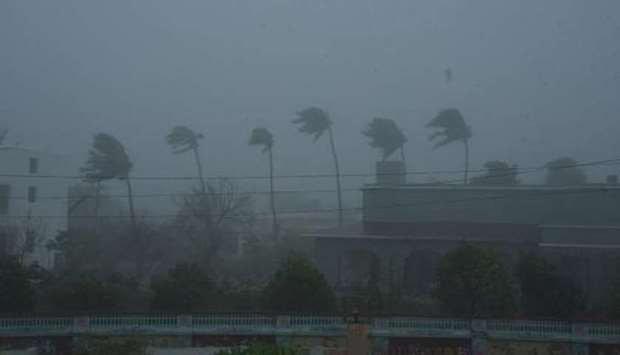A cyclone packing strong winds and rains barrelled into India’s east coast late yesterday, as tens of thousands of people in three states were evacuated to shelters.
Cyclones are a regular menace in the northern Indian Ocean but many scientists say they are becoming more frequent and severe as climate change warms sea temperatures.
Cyclone Gulab made landfall between the coastal states of Odisha and Andhra Pradesh just after 6pm local time (1230GMT), bearing gusts of up to 95km per hour, the state-run India Meteorological Department said.
The storm system from the Bay of Bengal would bring “strong winds and very heavy (and) extremely heavy rainfall”, the weather bureau added in an advisory earlier yesterday.
It added that there was a risk of flash flooding in some areas.
Odisha and Andhra Pradesh officials had ordered tens of thousands of people living along the coast to move to shelters, as hundreds of emergency workers were sent to the region.
There were reports of trees being uprooted as the cyclone slammed into a coastal district in Andhra Pradesh.
Some 85,000 families were moved from low-lying areas to temporary relief shelters in the state. Authorities in West Bengal - to the north of Odisha - said yesterday that, while Gulab appeared unlikely to hit the state directly, they were still taking precautions.
“We have so far evacuated more than 20,000 people to schools (and) government offices, which have been turned to cyclone shelters,” Bankim Hazra, a state minister responsible for the low-lying areas, said.
Odisha special relief commissioner P K Jena said seven districts in the state were on high alert and evacuation efforts were under way.
Ganjam, a coastal district, was expected to be badly hit by the cyclone, Jena added in a statement.
The Indian Navy has kept naval ships and aircraft on standby for rescue and relief operations.
Earlier the Eastern Naval Command in Visakhapatnam and naval officers in charge of Odisha carried out preparatory activities to combat the effects of the cyclone. The navy is in constant liaison with the state administrations for rendering assistance as required and closely monitoring the movement of the cyclonic storm.
In May, more than a million people were evacuated from their homes along India’s east coast before it was battered by Cyclone Yaas, with winds gusting up to 155km an hour — equivalent to a category two hurricane.
At least 20 people were killed and tens of thousands were displaced in the storm, which caused widespread damage worth more than $2bn in Odisha and West Bengal states and in neighbouring Bangladesh.

(Representative file photo)


